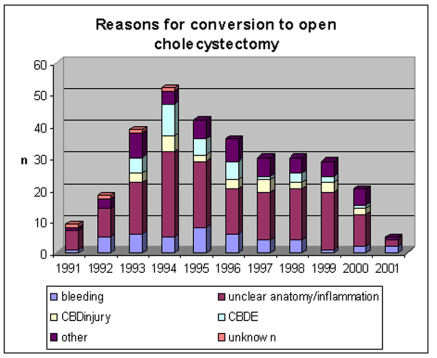# 107090 Abstract ID: 107090 Reasons for Conversion from Laparoscopic to Open Cholecystectomy: A 10-Year Review
Juliane Bingener-Casey, Melanie L Richards, William E Strodel, George B Kazantsev, Wayne H Schwesinger, Kenneth R Sirinek, San Antonio, TX
Background: Laparoscopic cholecystectomy has developed from an elective procedure for selected patients to the standard operation for gallstone disease. Still there are a number of patients who require conversion to an open cholecystectomy for the safe completion of the surgical procedure. This study investigates how the etiology and incidence of conversion from laparoscopic to open cholecystectomy has changed over time. Patients and Methods: All 5884 patients undergoing laparoscopic cholecystectomy from 3/91 until 6/01 were prospectively collected in a database. There were 4525 (76%) female and 1359 (24%) male patients with a mean age of 40 years. The reasons for conversion were reviewed. In four patients the reason for conversion could not be obtained. Results: 310 (5.2%) patients had their laparoscopic cholecystectomy converted to an open procedure, 180 (58%) women and 130 (42%) men with a mean age of 42 years. Causes for conversion were: Inability to identify anatomy correctly (50%), other, (e.g. equipment failure, unsuspected findings) (16%), bleeding (14%), suspected choledocholithiasis (11%) and suspected common bile duct injury (8%) and unknown (1%). Inclusion of complicated patients (acute cholecystitis, morbid obesity, prior abdominal surgery etc) resulted in a peak conversion rate of 11% by 1994. From 1994 to the first half of 2001 the conversion rates declined significantly: for all patients (10% to 1%), patients with acute cholecystitis (26% to 1%) and male patients (20% to 1%). Conclusion: Unclear anatomy and inflammation remain the most common reasons for conversion. With increasing experience the impact of acute cholecystitis on the operative outcome seems decreased. Conversion to an open procedure for common bile duct exploration is likely reduced secondary to the utilization of preoperative ERCP or laparoscopic common bile duct exploration.

|
 500 Cummings Center
500 Cummings Center +1 978-927-8330
+1 978-927-8330
 +1 978-524-0461
+1 978-524-0461